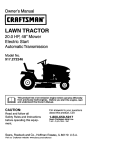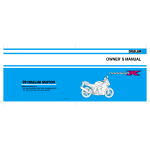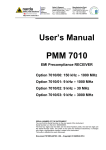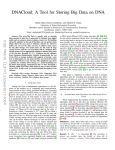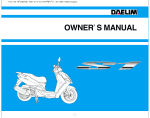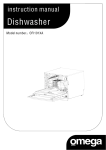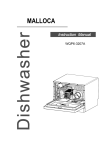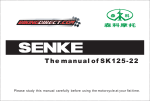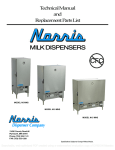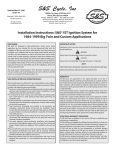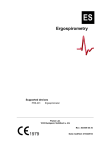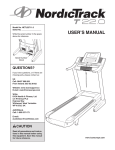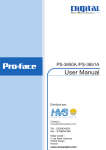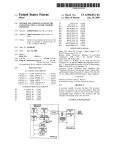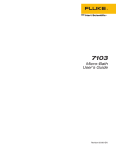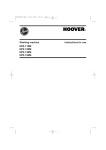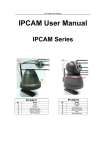Download Makes it easy to find manuals online!
Transcript
OWNER S MANUAL IMPORTANT NOTICE LCOME ank you for purchasing an Daelim vehicle. We hope you enjoy safe riding. ERATOR AND PASSENGER s motorcycle is designed to carry the operator and one passenger. WARNING empting to change the pre-set maximum speed may cause danger and will void the Daelim warranty. ROAD USE s motorcycle is designed to be used only on the road. AD THIS OWNER'S MANUAL CAREFULLY y special attention to statements preceded by the following words: WARNING cates a strong possibility of severe personal injury or death if instructions are not followed. CAUTION cates a possibility of personal injury or equipment damage if instructions are not followed. NOTE es helpful information. manual is an important and integral part of your vehicle. keep it with your vehicle at all times, even though your vehicle is resold. CONTENTS CIFICATION ...................................................................... 3 ERATION INSTRUCTION ............................................ 4 EQUIPMENT USAGE ........................................................ 15 AFETY PRECAUTIONS .................................................. 4 PRIOR TO STARTING VEHICLE ........................................ 5 TOOL BOX ......................................................................... 16 FUEL .................................................................................. 16 CORRECT ATTIRE ............................................................. 5 OPERATION ........................................................................ 6 CORRECT DRIVING OPERATION .............................. 17 STEERING WHEEL LOCK ................................................ 15 CARGO ................................................................................ 6 STARTING THE ENGINE .................................................. 17 IF ENGINE CANNOT BE STARTED ................................. 18 MODIFICATION ................................................................... 7 ATTACHMENT .................................................................... 7 GEAR SHIFTING ............................................................... 18 OPERATION ...................................................................... 19 MUFFLER ............................................................................ 7 ARTS LOCATION.............................................................. 8 HOW TO USE BRAKE ....................................................... 20 PARKING ........................................................................... 20 ETER READING AND USAGE................................... 10 SELF INSPECTIONS BEFORE OPERATION .......... 21 METER .............................................................................. 10 TACHOMETER .................................................................. 10 INSPECTION OF CONCERNED AREA ............................ 22 FUEL CHECK .................................................................... 22 INDICATOR LAMPS .......................................................... 11 MALFUNCTION INDICATOR LAMPS ............................... 11 BRAKES ............................................................................ 22 TIRES ................................................................................ 25 FUEL GAUGE .................................................................... 11 WITCH OPERATION ...................................................... 12 BATTERY INSPECTION ................................................... 27 THROTTLE GRIP .............................................................. 28 MAIN SWITCH ....................................................................12 HEADLIGHT·POSITION LAMP ....................................... 12 CLUTCH ............................................................................ 28 DRIVE CHAIN ................................................................... 30 ENGINE STOP SWITCH ................................................... 13 STARTER BUTTON .......................................................... 14 ENGINE OIL LEVEL CHECK ............................................. 31 CHANGING ENGINE OIL .................................................. 31 WINKER SWITCH ............................................................. 14 HORN BUTTON ................................................................. 15 LIGHTS AND WINKER ...................................................... 32 BACK MIRROR .................................................................. 33 LICENSE PLATE ............................................................... 33 1 AINTENANCE .................................................................. 33 MAINTENANCE SCHEDULE ............................................ 34 MAINTENANCE PRECAUTIONS ...................................... 38 FRAME AND ENGINE NUMBERS .................................... 36 AIR CLEANER ELEMENT ................................................. 37 WHEEL REMOVAL ............................................................ 38 TURNING METHOD .......................................................... 53 PRECAUTION WHEN TURNING ...................................... 54 BRAKING METHOD .......................................................... 55 BASIC PRINCIPLE OF BRAKE(FRICTION FORCE) ........ 56 RESTRAINT OF BRAKE EFFECT (INERTIA) .................. 56 BULB REPLACEMENT ...................................................... 40 BRAKING METHOD .......................................................... 56 COMPARISION OF BRAKING DISTANCE ........................56 SPARK PLUG .................................................................... 42 FUSE REPLACEMENT ..................................................... 43 IMPACT WHEN COLLISION ..............................................56 WIRING DIAGRAM ............................................................... 57 SIDE STAND ..................................................................... 44 CABLE RUBBER PART ..................................................... 44 NOTABLES FOR CAR WASHING .................................... 44 GENERAL CLEANING /IMPORTANT ............................... 45 STORAGE GUIDE ............................................................. 45 E DRIVING....................................................................... 47 REPARATION BEFORE DRIVING ............................ 47 RIVING METHOD ............................................................ 48 DRIVING POSITION ...........................................................48 PRECAUTION WHEN DRIVING ....................................... 49 STARTING ......................................................................... 50 RNING METHOD .......................................................... 51 PRINCIPLE OF TURN ....................................................... 51 EFFECT OF SPEED .......................................................... 51 3 POSITIONS OF TURNING ............................................. 52 SPECIFICATION ITEM DATA ITEM DATA LENGTH×WIDTH×HEIGHT(mm) 2,240×860×1,140 IGNITION SYSTEM TRANSISTOR WHEEL BASE(mm) 1,505 BATTERY CAPACITY 12V 10AH / MF TYPE GROUND CLEARANCE(mm) 135 FUEL CAPACITY(ℓ) 16.8 SEAT HEIGHT(mm) 720 DRYWEIGHT(kgf) 147.5 PASSENGER 2 ENGINE TYPE OIL COOLED/AIR COOLED 4 STROKE 4VALVE TIRE SIZE SUSPENSION BRAKE FR. 90 / 90 - 18 RR. 130 / 90 - 15 FR. TELESCOPIC RR. SINGLE ARM FR. HYDRAULIC DISK RR. DRUM BRAKE PISTON DISPLACEMENT(cc) 124.1 BORE AND STROKE(mm) 56.5×49.5 SPARK PLUG CR9EH-9 STARTING SYSTEM START MOTOR FUSE(A) 30A,15A, TRANSMISSION TYPE 5 STEPS RETURN 3 PERATION INSTRUCTION SAFETY PRECAUTIONS manual describes matters pertaining to correct operation, operation and simple maintenance of the vehicle you hased. nsure more comfortable and safer operation, e sure to read this manual carefully prior to operation. he photographs and drawings shown in this manual may ffer from those of actual vehicles due to changes in hicle specifications and modifications made. his vehicle is designed for 2 riders including the operator. CAUTION Do not use polluted gasoline. Otherwse it cause rust inside the fuel tank, and close the suppiy of fuel to the injector, leading to an improper engine starting or may cause serious damage to engine. Do use genuine oil, then it will protect and extend vehicle life. Warranty does not apply to the motorcycles used in competitions or competitive trials. No motorcycle part may be tampered with, altered, or replaced with parts other than original Daelim spare parts during the warranty period. As far as any defect caused by contaminated gasoline or oil, the warranty will be automatically invalidated. ●Careful driving and the wearing of proper attire and safety equipment are the most important factors in the safe operation of the daystar. Please obey traffic regulations and do not be hurried and careless. ●Many new vehicle owners operate their newly purchased vehicles with great care and attention to safety factors. However, after becoming accustomed to the operations are often discarded, which can lead to accidents. Please don't let this happen to you and always approach the operation of your vehicle with the safety considerations needed. When operating the vehicle, always keep in mind and obey the notes of precaution printed on the“Safety Precaution Label”attached to the vehicle. ●Be sure to wear helmet at all time. ●Be sure to put on gloves at all time. ●Observe the speed regulations. ●Beware of muffler affer driving as it is still hot to be burnt. Especially never children touch on it. ●For safety, do not change, alteration or modification the vehicle. ●Regularly conduct specified maintenance inspections. <Maintenance Inspection Points> Brakes, Tires, Oil, Lights, Horn, Instruments OR TO STARTING VEHICLE ad user's manual carefully. nduct maintenance checks prior to operation. ways maintain vehicle in clean status and carry out cified maintenance checks. ake sure to stop engine and stay away from fire when ling. haust gas contains harmful substance such as carbon noxide, Start engine in well-ventilated places. WARNING ●Be sure you and your passenger always wear a helmet, eye pretection and other protective apparel when you ride. ●Not wearing a helmet increases the chance of serious injury or death in a crash. Be sure to wear helmet at all time and the helmet chin strap secureiy fastened. Wear shirts or jackets with tight. RRECT ATTIRE Always put on gloves sure to wear helmet and gloves at all time for seafty. ar shirts or jackets with tight one while driving. Otherwise it can caught in the wheel to cause seriousdamage by overturn of hicle. ny automoble / motorcycle accidents happen because the omobile driver does not “Look” the motocyclist. Wear bright or reflective clothing. on’t ride in another motorist’s “Blind spot”. sure to wear dress to catch an eye to avoid any crash from hind. Choose fitting and low-heeled shoes. 5 PERATION CARGO ●When carrying cargo, you must keep in mind that operating the vehicle, especially when turning, will be different. ●Make sure not to overload the vehicle with goods as this can make the vehicle unstable during operation. CAUTION ●Pay attention not to overload goods and fasten it tightly whiling driving. ●Do not place kind of cloth materials nearby oil tank cap. If the hole in oil tank cap is clogged, oil will not flow freely into the engine which can cause severely engine damage. ●Do not attach large or heavy items (such as a sleeping bag or tent) to the handle bars, fork, or fender. Unstable handling or sliw steering response may result. DIFICATION WARNING odification of vehicle structure or function deteriorates nipulatability or causes exhaust noise to become louder ortening the vehicle life. These modifications are not only ohibited by law but also are the acts harmful to other ople. Modifications are not covered by warranty. CAUTION As far as any defect caused by modifications, the warranty will be automatically invalidated. TACHMENT cept designated attachment by DAELIM MOTOR CO., D., don’t attach any extra lighting device, because it may use an early discharging of battery. refully inspect the accessory to make sure it does not scure any lights, reduce ground clearance and banking gle, or limit suspension travel, steering travel or control eration. not add electrical equipment that will exceed the torcycle’s electrical system capacity. A blown fuse could use a dangerous loss of lights or engine power. is motorcycle was not designed to pull a sidecar or trailer. ndling may be seriously impaired if so equipped. ●Improper accessories or modifications can cavse a crash in which you can be seriously hurt or killed. ●Follow all instruction in this owneris manual regarding accessories and modifications. MUFFLER ●Pay particular attention to fellow passenger so that he/she can prevent getting burnt by the hot muffler during travel. CAUTION ●Beware of muffler after driving as it is still hot to be burnt. Especially never children touch on it. And pay attention to park where pedestrian zoon. ●If haystack or vinyl is stuck to the muffler, it might be fired. 7 TS LOCATION FUEL TANK CAP TOOL BOX FRONT BRAKE LEVER STEERING HANDLE LOCK PILLION STEP BAR BATTERY/FUSE REAR BRAKE PEDAL TS LOCATION CLUTCH LEVER RADIATOR SIDE STAND GEAR CHANGE PEDAL PILLION STEP BAR MAIN STAND AIR CLEANER ELEMENT 9 TER READING AND USAGE ETER EEDOMETER> ates speed in km/h during travel. tain legal speed limits to ensure safe tion. TACHOMETER SPEEDOMETER ODOMETER Indicates engine rpm. OMETER> ates total operating distance in km. P METER> ates travel distance from the point meter is reset to “0”. To reset meter, he trip meter knob to the direction of w. TRIP METER CAUTION ●As far as any defect caused by modifications, the warranty will be automatically invalidated. TRIP METER KNOB Pay particular attention because dle engine running or abrupt acceleration in the 1st or 2nd gear may cause the tachometer needle to be in the danger zone(red zone). Danger zone means the engine evolution limit and, if engine is un beyond this danger limit, engine will be damaged. ICATOR LAMPS ADLIGHT HIGH-BEAM INDICATOR> rned on when the headlight is in higham position. UTRAL INDICATOR> rned on when the main switch is in N” position and transmission gear in utral position. NKER INDICATOR> nks when turn signal is flashing. MIL<MALFUNCTION INDICATION LAMP> ●EMS(Engine Management System)is equipped with a self-diagnosis function in order to ensure that the engine control system is operation normally. ●If this function detects a malfunction in the system, the malfunction indicator lamp immediately operates. It gives the rider that malfunction has occurred in the system. ●Normally, the malfunction indicator lamp illuminates for 3 seconds when the main key is turned on. If the malfunction indicator lamp does not come on under these conditions, the malfunction indicator lamp may be defective. ●After 3 seconds, the malfunction indictor lamp off automatically. However, the MIL blinks continuously, check the EMS system. If you are not able to check the EMS system, contact your daelim dealers. ●The EMS takes fail-safe function, it enables to drive only temporary by starting even on conditioned. HEAD LIGHT HIGH-BEAM INDICATOR NEUTRAL INDICATOR MALFUNCTION INDICATION LAMP WINKER INDICATOR FUEL GAUGE Indicates amount of gasoline in fuel tank. If needle is within E mark(red zone), immediately fill gasoline. ●Fuel Capacity:16.8ℓ ●Reserve fuel capacity:4.3ℓ FUEL GAUGE WARNING ●To avoid running out of fuel,it might cause serve injury due to engine abruptly stop. 11 TCH OPERATION IN SWITCH CAUTION switch is used to turn on or turn off e. ey tion N FF Function Key removal Starts engine. Used Cannot be to operate vehicle removed during day or night time, to operate horn, winker, brake lights or head lights. Stops engine. Cuts Can be off all electrical removed circuits. MAIN SWITCH ●Do not operate main switch key during operation. ●If the main switch key is placed on “Off” or“Lock”position, all electrical system will not function. ●Never operate the main switch key during travel as it might cause unexpected accidents. ●If it is necessary to remove the main switch key, stop the vehicle first prior to removing. ●Prior to dismounting from the vehicle, make sure to lock the steering wheel and remove key. ●If the key is left in “ON” position without starting engine, battery is discharged. ●Do not use a number of keys together with a metal key holder. The keys and the key holder may cause scratches or other damage to the cover while operating the vehicle.(Recommend cloth or leather key holders) HEADLIGHT·POSITION LAMP <TURNING ON HEADLIGHT> Put main switch key in “ON” position and turn on headlight switch. Switch position Switch position (H) Headlight, position lamp and taillight turned on (P) Position lamp and taillight turned on. Light turned off ●Position lamp( advises approaching vehicle of the motor cycle position when operating after sunset. In addition, when the motor cycle is stopped at night or at an intersection, the position lamp advises other vehicles of the motorcycle existence without blinding operators. <HEADLIGHT HIGH OR LOW BEAM OPERATION> High beam or low beam can be operated by the use of high/low beam switch. (HI)... Headlight placed on high beam (LO)... Headlight placed on low beam ENGINE STOP SWITCH This switch is the device for immediate engine stop by hand in any emergencies. In normal condition, make sure its position “ ”(RUN), and do not use on the position of “ ”(OFF). ENGINE STOP SWITCH HEADLIGHT SWITCH HEADLIGHT HIGH/LOW BEAM SWITCH CAUTION ●Use this engine stop switch in emergencies. ●When this engine stop switch changes as “ ”(RUN)→“ ” (OFF)→“ ”(RUN) during travel, engine cannot operate properly and also it causes unsafety riding. Make sure the engine can be damaged by this kind of misuse. ●When you make engine stop by this switch, the main switch must be in “ ”(OFF) position. If the key is left in “ON” position without starting engine, battery is discharged. ●If this switch is left in “ ”(OFF) position, engine cannot be started. 13 ARTER BUTTON WINKER SWITCH er motor runs while this button is ed to start engine. Use winker switch when you turn to left or right, or when you change course of travel. <HOW TO USE> If this switch is turned on when the main switch is in “ON” status, turn signal is brinking. To release, turn signal operation, press the winker switch. ⇨ (R) .... Turn to right ⇦ (L) .... Turn to left STARTER BUTTON CAUTION ●Do not run starter motor continu-ously. Because the starter motor consumes great amount of power, continuous running of starter motor might cause battery to exhausted. WINKER SWITCH CAUTION Using light-bulbs with wrong watts may cause malfunction to the winker switches. Always use lightbulbs with prescribed watts. The winker switch does not automatically turn back to its original position after completing the turn. Please set the switch back to its center position after turning. Driving the vehicle with the light on may hinder traffic. UIPMENT USAGE RN BUTTON STEERING WHEEL LOCK n button is pressed when main switch “ON” position, horn is sounded TTON To prevent theft, lock steering wheel when parking the vehicle. <HOW TO LOCK> 1. Turn the steering wheel to left completely. 2. Insert main switch key. 3. Turn the key 180°to the right. If the steering wheel cannot be locked, move the steering wheel slightly to right and left while turning the key. 4. Remove the key. STEERING WHEEL LOCK CAUTION <HOW TO RELEASE> 1. Insert main switch key. 2. Turn the key 180°to the left. 3. Remove key. ●To make sure steering wheel is locked properly, lightly turn steering wheel to left and right and right and verify lock. ●Park the vehicle in places free of traffic. ●Prior to operation, turn the steering wheel to left and right to verify if turning angles of left and rights are equal. 15 OOL BOX FUEL e is a tool box inside the right front cover. Safeguard tools inside the tool W TO USE> main switch key to open or close the box cover. TOOL BOX <REFULELING> ●Open key cover ; insert main switch key ; turn key to right and fuel tank cap is opened. ●Fill gasoline up the bottom of level plate located at the lower side of tank mouth. ●Push the tank cap correctly with hands and remove the main switch key. (If the fuel tank cap is not locked, the main switch key will not be removed) FUEL CAPACITY : 16.8 CAUTION CAUTION ●Put tools inside the tool box, and lock it with O-ring as noise might occur while the vehicle is moving ●Make sure to stop engine and stay away from fire when fueling. ●If gasoline is filled aboved the level plate bottom, gasoline may overflow. MAIN SWITCH KEY FUEL TANK CAP KEY COVER RRECT DRIVING OPERATION ake sure to check the oil, gasoline, ., before starting the engine. ase ensure that the main stand and side stand is in a up-position when rting the engine. ke sure that the front wheel is locked en starting the engine. ve with care for both safety reasons d longer vehicle life. r 1month(or 1,000km) after purcsing the vehicle, drive moderately oiding fast starts and fast acceleration. STARTING THE ENGINE <WHEN ENGINE IS COLD> 1. Verify the steering weel lock is released. 2. Make sure engine stop switch is in “ ” (RUN) position 3. Make sure fuel cock lever is in “ON” position. 4. Turn on main switch. 5. Put gear in neutral. (Verify this with neutral indicator lamp) 6. Press the starter button without rotating the throttle. 7. If engine is not started with throttle grip closed, press starter button and open throttle grip approximately 1/8 to 1/4. 8. Once engine is started, pull and release throttle grip repeatedly to run engine idle until engine is heated. 9. Verify side stand is positively in original position and start slowly. CAUTION <WHEN ENGINE IS HOT> 1. Verify the steering wheel lock is released. 2. Make sure engine stop switch is in “ ” (RUN) position. 3. Turn on main switch. 4. Put gear in neutral.(Verify this with neutral indicator lamp) ●Do not press the starter button when the engine is running. this can damage the start motor. ●Keep hold brake lever when starting. 17 ARTING THE ENGINE ose throttle grip and press starter tton. engine is not started with throttle grip osed, press starter button and open ottle grip approximately 1/8 to 1/4. erify side stand is positively in ginal position and start slowly. 1/8 1/4 IF ENGINE CANNOT BE STARTED CAUTION ●Exhaust gas contains harmful substance such as carbon monoxide. Start engine in wellventilated places. ●If engine is not started within 3 seconds after starter button is pressed, wait for approximately 10 seconds and retry. This is to recover battery voltage. ●Do not run engine idle unreasonably. This not only wastes fuel but also adversely affects engine. ●If starter button is pressed without disengaging clutch, motorcycle may bring out to fall. Make sure gear is in neutral position or disengage clutch prior to starting engine. If engine cannot be started or vehicle does not move, check the followings. ●Is there fuel in fuel tank? ●Are you operating in accordance with the instructions given in owner’s manual? ●Is fuse not cut? ●Is starter motor running? ●If starter motor is not running due to battery consumption, charge the battery. ●If the MIL blinks continously when the main key is on, contact daelim dealer. GEAR SHIFTING Gear is shifted in 5-shift return system as shown on the right side drawing. ●Close throttle grip and hold clutch lever perfectly, and shift gear. ●Touch pedal lightly with foot and shift gear perfectly until you hear “Click” at the pedal. If you apply excessive force when shifting gear, transmission may be damaged. OPERATION AR DOWN OPERATION> u gear down when you need to drastiaccelerate speed such as when you assing another vehicle, speed can be erated. If you ride too fast, it adly affects engine because engine revn is excessive. 23 4 GEAR CHANGE PEDAL 5 ●Make sure side stand is in original position prior to starting vehicle. ●If side stand moves unsatisfactorily, check lubrication state on side stand joint. ●Shift gear adequately according to vehicle speed. The table on the right side shows speed ranges. ●To save fuel and maintain optimum vehicle life, do not accelerate or decelerate speed abruptly. CAUTION ●Always start in the 1 st gear, and start carefully as slow as possible. ●If you hear abnormal noise during travel, contact authorized maintenance shop immediately for inspection and necessary action. ●Maintain legal speed limits. <BREAK-IN OPERATION> ●For 1month (or 1,000km)after purchasing the vehicle,drive moderately avoiding fast starts and fast acceleration. ●Maintain engine revolution at a level less than 6,000rpm for first 1,000km to break in vehicle. If vehicle is break in as above, It will extend vehicle life. 19 W TO USE BRAKE ply brakes on front wheel and rear eel simultaneously. oid unnecessary abrupt braking. CAUTION f you apply brakes only on front wheel or rear wheel, vehicle may slide off sideway and fall. f you apply brakes abruptly during travel in rain or on wet oad, tires slide off and may cause accidents. Reduce speed and apply brake cautiously. Avoid repeated brake operation as t may cause brake temperature to ise, leading to braking effect deterioration. PARKING <ENGINE BRAKE> If you turn throttle grip in reverse, engine brake functions and, if you need stronger braking, shift gear down from 4th to 3rd and so forth. When you travel on a long descent or on a sharp descent, use intermittent braking technique and engine brake simultaneously. CAUTION ●Do not shift to lower gear while traveling at an excessive speed as it may suddenly increase the engine speed, adversely affect the engine and transmission, and cause the rear part of the vehicle to be shaken. ●Put gear in neutral and put main switch to “OFF” position to stop engine. ●Put fuel cock to “OFF” position. ●Put vehicle on main stand and park on level ground in places free of traffic. If you park vehicle on an uneven ground, vehicle may fall. CAUTION ●Select a safe place free of traffic and park vehicle. ●Muffler is hot. Park vehicle in places where there is no danger of people making contact with vehicle. F INSPECTIONS BEFORE OPERATION RKING WHEN SIDE STAND IS USED> vehicle on level ground and park with eering wheel turned to left. vehicle is parked in the following vehicle may fall to side. he vehicle is parked with the steering eel turned to right, or if parked on a pe, sandy places, uneven ground or t ground, vehicle may fall. is necessary to park in an unstable ound under unavoidable situation, ke sufficient safety measures to vent vehicle from falling or moving. Self inspect the motorcycle and have regular maintenance inspections for increased safety and the prevention of accidents. Self inspections before operation should be performed an a daily basis prior to operating the vehicle. ●Inspections of areas of concern. ●Fuel check ●Brake inspection ●Tire inspection ●Throttle grip Inspection ●Clutch inspection. ●Drive chain inspection. ●Engine oil inspection. ●Lights and winker inspection. ●Back mirror inspection. ●License plate inspection. CAUTION Observe safety rules when conducting inspections. ●Exhaust gas contains harmful substance such as carbon monoxide. Do not carry out inspections on vehicle in closed places, or in poorly ventilated places, with engine running. ●Conduct inspections on flat, solid ground with the stand erected. ●Be careful of burns when conducting inspections immediately after engine is stopped because the engine and muffler are hot. ●Stop engine and remove the key prior to the vehicle maintenance service. ●If you are unable to correct trouble even after you make adjustment or correction, contact authorized maintenance shops, dealers or designated repair shops for necessary inspection and repairs. 21 PECTION OF CONCERNED AREA k areas which caused for concern last operating the vehicle. EL CHECK ck gasoline to see if there is a cient amount of gasoline to reach your nation. to page 16 for refueling. BRAKES The front brake is the hydraulic disk type, and the rear brake is the drum brake type. As the brake pad wear, the brake fluid level drops. There are no adjustments to perform, but fluid level and pad wear must be inspected periodically. The system must be inspected frequently to ensure there are no fluid leaks. <BRAKE FLUID LEVEL> [FRONT WHEEL] Put main stand in upright position on a flat ground and operate steel wheel, and check fluid when the top of master cylinder cap is level. Check fluid level to see if it is below lower level. If fluid significantly low, it may indicate fluid leakage on brake system. If this happens, check fluid leaks or brake system. If this happens, check fluid leaks or damage on system and inspect joints and clamps for looseness. <BRAKE LEVER FREE PLAY> Lightly squeeze the brake levers until tension is felt to check for an appropriate amount of free play. No free play in the brake levers or overly loose brake levers are indication of a problem in the brake system. BRAKE LEVER FREE PLAY : 10~20mm WARNING ●Brake fluid may cause irritation. Avoid contact with skin or eyes. In case of contact, flush thoroughly with water and call a doctor if your eyes were exposed. ●KEEP OUT OF REACH OF CHILDREN. dition, check hose and pipe protective o sec if they make contact with other when you make left or right turn due ration during travel. R LEVEL ENGINEC STOP <REPLENISHING BRAKE FLUID> ●Move steering wheel and set the top of reserve tank level. ●Clean dust and other foreign matter from around master cylinder and take caution not to allow foreign matter to fall inside master cylinder ●Open cap screw and remove diaphragm. ●Replenish recommended brake fluid to upper level inside master cylinder. Tighten cap accurately, paying attention to the direction of diaphragm assembling, and avoid ingress of foreign matter. SCREW MASTER CYLINDER CAP DIAPHRAGM PLATE DIAPHRAGM UPPER LEVEL RECOMMENDED BRAKE FLUID IS DOT 3 CAUTION Brake is an important part which rotects your life. Make sure to nspect brake prior to daily use. 23 CAUTION Do not fill brake fluid above upper evel as it may cause brake fluid to eak outside. Exercise full caution, when eplenishing brake fluid, not to allow dust or water to mix inside master cylinder. f the amount of brake fluid decreases considerably, it is an ndication of brake system trouble. To prevent occurrence of chemical change, do not use brake fluid of different manufacturer. Do not let brake fluid contact vehicle parts because it causes damage to painted parts. <BRAKE PAD INSPECTION> Operate brake and, if the brake pad wear limit line reaches the brake disc side, it indicates the pad has reached wear limit. WEAR LIMIT LINE [REAR WHEEL] Push the brake pedal with hands for resistance and check if the pedal movement appropriate. If brake pedal movement is inappropriate, adjust the pedal free play using the rear wheel brake adjuster nut. ●To adjust pedal free play, turn adjuster nut. After adjustment, push the brake pedal with hands until you feel resistance and verify the pedal free play is within prescribed level. BRAKE PEDAL FREE PLAY : 20~30mm TIRES 20~30mm <BRAKE SHOE INSPECTION> Push brake pedal completely and, if the brake arm arrow and the “△” on brake panel match each other, it indicates brake shoe has reached its life limit. ARROW MARK “△” MARK BRAKE PEDAL <TIRE PRESSURE CHECK> Check for an appropriate level of air pressure by examining how the tire sits on the ground. If you notice any abnormalities in the shape of the tire with regard to the area contacting the ground, use a tire gauge to check tire pressure and adjust the tire pressure to the appropriate level. <TIRE PRESSURE> SIZE CAUTION ADJUSTER NUT ●In case brake pad or shoe reaches the wear limit line, replace it immediately. Worn brake pad can cause an accident due to lack of power. 90/90-18 130/90-15 1 PERSON FRONT 2.00 RIDING REAR 2.00 FRONT REAR TIRE PRESSURE 2 PERSON FRONT (kg/ ) RIDING REAR 2.00 2.00 25 RES ACKS/DAMAGE> k tire tread and sides for cracks and ge. CRACKS NAILS <TREAD DEPTH> ●Check the wear indicator(wear limit marking) to see if there is an insufficient amount of tread remaining. ●If the indicators are visible, replace tire with a new one. WEAR INDICATOR (WEAR LIMIT MARKING) ROCKS DAMAGE NORMAL WEAR> k tire tread for signs of abnormal ABNORMAL WEAR <FOREIGN MATTER> Check tire tread and sides for nails, rocks, etc. That might have become wedged in the tire. CAUTION ●If air pressure is inadequate or if there are cracks, damage or abnormal wear on tires, it may cause trembling steering wheel and flat tire. ●This vehicle is equipped with tubeless tires. If you have flat tires, please contact authorised maint-enance shops for inspection. WEAR INDICATOR LOCATION MARKING TTERY TTERY INSPECTION> move the four flange bolts, and take the right lower cover. you can find battery, If the battry terminal is luted or in rust, separate battery and an it. RIGHT LOWER COVER ttry terminal in rust with white wder should be cleaned with warm ter. case of serious rust of battry terminal, assemble the battery cord and grind it h wire brush or sandpaper. CAUTION ●Turn the ignition switch OFF before disconnecting the terminal from the battery. Disconnect the negative(-) terminal lead from the battery first. When connecting, connect the positive(+) terminal lead first. If you work in reverse order, short circuit will occur resulting in fire. ●Make sure that terminals do not contact with other adjacent parts when handling (+), (-) terminals. Contact with other parts may cause spark resulting in electrical equipment malfunction, fire and electric shock. ●Do not apply excessive impact. When handling the battery, stay away from flammable materials. ●If the electrolyte contact with terminal, it will be corroded earlier. ●The battery is shield type, so do not disassemble the pouring plug. ●When not using vehicle during a long time, take off the battery from the vehicle to keep from self-discharge and electric discharge. Put the battery in a well ventilated place after charging fully. In case it isn’t available to take battery off from the vehicle, disconnect (-) terminal. CAUTION ●When using the battery without cover, (+), (-) terminals may be connected to cause short circuit resulting in fire. When handling the battery, stay away from flammable materials. ●Your battery is a maintenance-free type so check or refilling of electrolyte will not be required. If there is any abnormal, contact to Daelim service center. ●If you reform the battery for car, battery will be improperly installed to cause short circuit resulting in fire. ●If the electrolyte gets into your eyes or on skin, it’ll cause a serious injury. ●Do not discard the battery other than specified place. It will bring environmental contamination, and be brought under the law 27 HROTTLE GRIP CLUTCH eck for smooth rotation of the throttle p from the fully open to the fully osed position at both full steering sitions. easure the throttle grip free play at the ottle grip flange. e standard free play should be approx ~6 mm adjust the free play, turn the adjuster. ADJUSTER <LEVER FREE PLAY INSPECTION> Pull clutch lever until you feel resistance, and using a graduated ruler, check the lever end free play to verify it is within prescribed level. 10~20mm <CLUTCH OPERATION> ●When engine is idling, pull clutch lever all the way and see if there is abnormal noise or if you feel unusual heaviness. ●Slowly release clutch lever and start. Check at this time to see if clutch is engaged smoothly without slipping. <CLUTCH LEVER ADJUSTMENT> Adjust lever free play by using the clutch cable’s clutch lever side or clutch side adjuster. ●To make major adjustment, loosen the clutch side lock nut and adjust by operating the adjuster. ●For fine adjustment, loosen the clutch lever side lock nut and turn adjuster. ●After adjusting, tighten lock nut. After adjustment is completed, pull clutch lever with hands until you feel resistance and verify the lever free play is within prescribed level. CLUTCH LEVER FREE PLAY: 10~20mm CAUTION ●Upon completion of adjustment, start engine and verify gear change pedal is operating smoothly. DRIVE CHAIN AJOR ADJUSTMENT LOCK NUT TER NE ADJUSTMENT ADJUSTER LOCK NUT ●The service life of drive chain is dependent upon proper lubrication and adjustment. Poor maintenance can cause premature wear or damage to the drive chain and sprocket. ●The drive chain should be checked and lubricated as part of the Pre-ride Inspection. ●Under severe usage, or when the motorcycle is ridden in unusually dusty or muddy areas, more frequent maintenance will be necessary. 3. Move the position of chain tensioner roller up and down with hands to check if the chain free play is within recommended range. OPTIMA FREE PLAY : 50~60 mm 50~60mm <INSPECTION> 1. Turn the engine off, put vehicle in upright position on the main stand and shift the transmission into neutral. 2. Remove the chain tensioner. CHAIN TENSIONER ROLLER 29 RIVE CHAIN tate the rear wheel slowly and inspect drive chain and sprockets for any of follwing conditions : RIVE CHAIN ① Damged rollers ② Loose Pins ③ Dry or Rusted Link ④ Kinked or Binding Link ⑤ Excessive Wear ⑥ Improper Adjustment ⑦ Missing O-ring PROCKETS ⑧ Excessively Worn Teeth ⑨ Broken or Damaged Teeth drive chain with damaged rollers, ose pins or missing O-ring must be placed. chain which appears dry or shows gs of rust, requires supplementary brication. <ADJUSTMENT> ●Drive chain slack slould be checked and adjusted, if necessary, every 1,000km. ●When operated at sustained high speeds or under conditions of frequent rapid acceleration, the chain may requir more frequent adjustment. 1. Place the motorcycle on its side stand with the transmission in neutral and the ignition switch off. 2. Remove the chain tensioner. 3. Loose the axle nut. 4. Loose the lock nuts on both sides of the swingarm. 5. Turn both adjusting nuts an equal number of turns until the correct drive chain slack is obtained. Turn the adjusting nuts clockwise to tighten the chain or counter clockwise to provide more slack. Rotate the rear wheel and recheck slack at other section of the chain. OPTIMA FREE PLAY : 50~60 mm 50~60mm ADJUSTER NUT CHAIN TENSIONER 6. Tighten the axle nut to specified torque. ·m AXLE NUT TORQUE : 6.0~8.0 kgf· 7. Tighten the adjusting nuts lightly, then tighten the lock nuts by holding the adjusting nuts with a spanner. 8. Install the chain tensioner. ENGINE OIL LEVEL CHECK WARNING a torque wrench is not used for this stallation, see your authorized aler as soon as possible to verify oper assembly. CAUTION f a torque wrench is not used for his installation, see your uthorized dealer as soon as possible to verify proper assembly. Make sure the right and left chain djuster graduations are set in the ame position. After adjusting chain, check the ear brake pedal free play. New motorcycle adapts endlessype drive chain. (end-type for ffer-sales service purpose) After once disassembling chain, chain clip can be accidentally emoved, so change new one after disassembling chain even once. ●Put vehicle in upright position on flat ground and check engine oil level and degree of pollution. ●Run engine idle for approximately 2~3 minutes on flat ground and stop engine. Approximately 2~3 minutes thereafter, put vehicle in upright position and check engine oil and verify the oil level is between the upper and lower level of oil level gauge. ●Insert oil level gauge, without locking, and check oil level after removing oil gauge. ●If the oil level is near lower level, replenish oil to upper level. UPPER LEVEL LOWER LEVEL CHANGING ENGINE OIL If engine oil is polluted, it seriously affects the engine life span. Maintain appropriate level of oil, use correct type of oil and observe oil exchange period. ●Stand vehicle on the main stand on level ground and run engine idle (warm up) for approximately 2-3 minutes. ●Stop engine and place a container under the engine. Remove oil level gauge and drain bolt. ●Clean oil filter screen. ●Check the condition of oil filter screen seal rubber and, O-ring. ●Close oil filter screen, spring, and oil drain bolt, and replenish oil up to the upper level of the oil level gauge. OIL CAPACITY: 1.2 WARNING ●Be sure to keep oil away from children and pets. Dispose of used oil properly. OIL LEVEL GAUGE 31 HANGING ENGINE OIL COMMENDED OIL> sold on markets or privately-manured oil(low-grade) is used, engine life versely affected, and the privilege of anty repairs cannot be guaranteed. I Service classification : SE or SH cosity : SAE10W-40 LIGHTS AND WINKER CAUTION ●If you change engine oil immediately after engine is stopped, be careful of burns because the engine, muffler and engine oil are still hot. ●Exercise caution not to allow dust or other foreign matter to flow in when refilling engine oil. If oil overflows, wipe off oil clean. ●If oil level is lower or higher than prescribed level, engine is adversely affected. ●Do not mix oil with those of different manufacturers or grade, or do not use low-quality oil as it may cause deterioration of oil, leading to accidents. ●Clean the oil filter screen with fresh cleaning oil every 4,000km. ● Be careful not to lose the oil filter screen spring when assembling the oil drain bolts. [HEAD LIGHT, TAIL LIGHT] Start the engine and make sure the lights turn on. Also check to see if the lights are damaged or if there is dirt on them. [BRAKE LIGHT CHECK] Turn the main switch to ON. While separately operating the front and rear brakes, check to see if the brake light turns on. Also check to see if there is any damage to the lens or if there is dirt on the brake light. [WINKER CHECK] Turn the main switch to ON. Check to see if all the winker in the front and rear of the vehicle(including left and right sides) are flashing properly, At the same time, check to make sure that the automatic sound signal of the winker is working. Check also to see if any of the lens are damaged or dirty. NTENANCE ACK MIRROR uarely on the seat and check to see if have a good view behind the vehicle oking at the rear view mirrors. Also for dirt and damage on the rear view rs. CENSE PLATE ●The Required Maintenance Schedule specifies how often you should have your motorcycle served, and what things need attention. ●It is essential that your motorcycle be served as scheduled to retain its high level of safety, dependability, and emission control performance. ●These instructions are based on the assumption that the motorcycle will be used exclusively for its designed purpose. Sustained high speed operation, or operation in unusually wet or dusty conditions, will require more frequent service than specified in the MAINTENANCE SCHEDULE. Consult your authorized Daelim dealer for recommendations applicable to your individual needs and use. k to see if there is any dirt or damage license plate. check to see if the license plate is y secured to the vehicle. 33 AINTENANCE SCHEDULE rm the Self Inspections Before Operation at each scheduled maintenance period. SPECT AND, CLEAN, ADJUST, LUBRICATE OR REPLACE IF NECESSARY EPLACE L: LUBRICATE C: CLEAN ODOMETER READING(NOTE 1) FREQUENCY ×1,000Km TEM 1 MONTH 4 8 12 6 12 18 ★ FUEL LINE I I I I ★ FUEL FILTER R R R R ★ THROTTLE OPERATION I I I I AIR CLEANER C C C SPARK PLUG I R I ★ VALVE CLEARANCE I I I I ★ ENGINE OIL R R R R ENGINE OIL FILTER R R R R ★★ DRIVE CHAIN Every 1,000 : I and L REMARK NOTE (2) ODOMETER READING(NOTE 1) FREQUENCY ITEM ×1,000Km 1 MONTH 4 8 12 6 12 18 ★ BRAKE FLUID I I I ★ BRAKE SHOE / PAD WEAR I I I I I I BRAKE SYSTEM I ★ BRAKE STOP SWITCH I I I ★ HEADLIGHT ADJUSTMENT I I I ★ SUSPENSION I I I I I I I I I ★ CLUTCH I SIDE STAND BOLTS, NUTS, FASTENERS ★★ WHEELS / TIRES ★★ STEERING HANDLE BEARING I NOTE (3) I I I REMARK I I I If you do not have the appropriate tools or information to conduct maintenance, or if you feel you are not capable to perform maintenance on this vehicle, contact authorized dealers or repair shops for maintenance and repairs. To ensure safety, inspections and maintenance of these parts must be carried out by dealers, or repair centers. TES : (1) At higher odometer readings, repeat at the frequency interval established here. (2) Service more frequently when riding in unusually wet or dusty areas. (3) Replace every 2 years, or at indicated odometer interval, whichever comes first. Replacement requires mechanical skill. 35 INTENANCE PRECAUTIONS FRAME AND ENGINE NUMBERS CAUTION ollowing is an explanation of correct ection methods, cleaning and parts cing. Please always refer to this on when wanting to inspect or repair vehicle. WARNING your motorcycle is overturned or volved in a collision, inspect ntrol levers, cables, brake hoses, lipers, accessories, and other vital rts for damage. Do not ride the otorcycle if damage impairs safe eration. Have your authorized aelim dealer inspect the major mponents, including frame, spension and steering parts, for isalignment and damage that you ay not be able to detect. se new, genuine Daelim parts or eir equivalent for maintenance and pair. Parts which are not of uivalent quality may impair the fety of your motorcycle and the fective operation of the emission ntrol systems. ●Always observe safety rules when performing maintenance on the vehicle. ●Choose a flat surface and make sure the main stand is in a secure down position. ●Use correct tools. ●Conduct engine maintenance with the engine key out of the ignition. ●Be careful around the engine and muffler when performing maintenance as these areas can become extremely hot. ●After self maintenance, the waste material must be packed in the specified container and entrusted disposal to the authorized disposal company. ●Exhaust gas contains harmful substance such as carbon monoxide. Do not carry out inspections on vehicle in closed place, or in poorly ventilated places, with engine running. The frame and engine numbers are needed when registering motorcycle or when ordering parts. ●Frame number is stamped on the right side of steering head. ●Engine number is stamped on left crank case. FRAME NUMBER ENGINE NUMBER R CLEANER ELEMENT AIR CLEANER ELEMENT PECTION> is vehicle is equipped with viscous e air cleaner element containing oil d the element cannot be cleaned. place element after each operation of 00km. ASSEMBLING> osen four screw and remove air aner case cover. osen four washer screw and air aner element. SEMBLING> semble in the opposite order of assembling. SCREW WASHER SCREW CAUTION ●If air cleaner element is inadequately assembled, dust and other foreign matters are absorbed directly into the element, inducing cylinder wear or output deterioration and adversely affecting engine durability. Assemble correctly. ●When cleaning vehicle, be careful not to allow water to get into air cleaner. If water gets inside air cleaner, it causes inefficient engine starting. AIR CLEANER CASE COVER 37 HEEL REMOVAL ONT WHEEL REMOVAL] aise the front wheel off the ground by lacing a support block under the ngine. oose the oval screw and remove the peedometer cable. emove the front caliper assembly om the fork by removing the fixing olts. ④ Loosen the axle nut. ⑤ Withdraw the front wheel axle and remove the front wheel. FRONT WHEEL AXLE ●Fit the caliper over the disc, taking care not to damage the brake pads. Install the caliper fixing bolts, and tighten to a ·m torque of : 2.7kgf· ●Tighten the front axle nut to the specified torque. FRONT AXLE NUT TORQUE : ·m 5.0~7.0kgf· FRONT CALIPER LE NUT ⑥ Install in the reverse order of removal. OVAL SCREW SPEEDOMETER CABLE CAUTION Do not operate brake lever after he front wheel is removed. It will make wheel assembling difficult. ⑦ After assembling, operate brake for a number of times and see if wheel is turning smoothly without getting interruption. WARNING CAUTION ●When installing the wheel, carefully fit the left brake disk between the brake pads to avoid damaging the pads. ●If a troque wrench was not used for installation, see your authorized dealer as soon as possible to verify proper assembly. Improper aseembly may lead to loss of braking capacity. AR WHEEL REMOVAL] et vehicle on main stand in upright osition on level ground. oosen the rear brake adjuster nut and move the brake rod. AKE ARM WARNING ●If a troque wrench was not used for installation, see your authorized dealer as soon as possible to verify proper assembly. CHAIN ADJUSTER NUT Improper aseembly may lead to loss of braking capacity. REAR WHEEL AXLE CHAIN TENSIONER ⑥ Install in the reverse order of removal. REAR AXLE NUT TORQUE : ·m 6.0~8.0 kgf· BRAKE ROD emove the chain tensioner. oosen the chain adjuster nut. oosen the rear weel axle nut and move the rear wheel axle and the rear heel. ●After installing the wheel, apply the brake several times and then check if the wheel rotates freely. Recheck the wheel if the brake drags or if the wheel does not rotate freely. 39 ULB REPLACEMENT sure to turn the ignition switch OFF en replacing the bulb. o not use bulbs other than that ecified. ter installing a new bulb, check that light operates properly. [HEADLIGHT BULB] ① Loosen the washer screw and remove the headlight. SOCKET HEADLIGHT WARNING he light bulb becomes very hot hile the light is ON, and remain hot r a while after it is turned OFF. Be re to let it cool down before rvicing. CAUTION Do not put finger prints on the headlight bulb, as they may create hot sports on the bulb and cause it to break. Wear clean gloves while replacing the bulb. If you touch the bulb with your bare hands. clean it with a cloth moistened with alcohol to prevent its early failure. MARKER LIGHT BULB HEADLIGHT BULB ② Pull off the socket without turning. ③ Loosen the spring and remove the headlight bulb. ④ Install a new bulb in the reverse order of removal. HEADLIGHT BULB : 12V 60/ 55W L/STOPLIGHT BULB] oosen the tapping screw and remove e taillight lens. lightly press down on the bulb and rn it counterclockwise. stall a new bulb in the reverse order removal. AIL/STOPLIGHT BULB:12V 21/5W [LICENSE LIGHT BULB] ① Loosen the tapping screw and remove the license light lens. ② Slightly press down on the bulb and turn it counterclockwise. ③ Install a new bulb in the reverse order of removal. LICENSELIGHT BULB: 12V 5W [FRONT/REAR WINKER BULB] ① Loosen the tapping screw and remove the winker lens. ② Slightly press down on the bulb and turn it counterclockwise. ③ Install a new bulb in the reverse order of removal. WINKER BULB : 12V 10W TAPPING SCREWS TAIL & STOP BULB TAPPING SCREW WINKER LENS TAPPING SCREWS TAILLIGHT LENS LICENSE LIGHT LENS MARKER LIGHT BULB WINKER BULB 41 ARK PLUG ectrode is stained or plug gap is not satisfactory spark is not produced. n and make adjustment. move spark plug cap. ean around the plug. ing a plug wrench, remove plug. ean plug with plug cleaner. eck electrode for wear and corrosion. he center of electrode became round, lace the electrode. easure the spark plug gap using a ler gauge. LUG GAP: 0.8-0.9mm ghten with hands until the plug sher touches cylinder head. TANDARD PLUG: CR9EH-9 new plug is installed, turn 1/2 and hten using a plug wrench. plug is reused, turn 1/3~1/4 and tighten. CAUTION PLUG GAP ●If plug of different maker or different heat value is used, it causes unsatisfactory engine starting, inadequate engine revolution and output deterioration. ●The spark plug must be securely tightened. An improperly tightened plug can become very hot and possibly damage the engine. ●To install a spark plug, turn it in as far as possible with your fingers, then tighten it with a wrench. Do not overtighten or cross thread the spark plug or the aluminum threads of the cylinder head will be damaged.Do not allow contaminants to enter the engine through the spark plug hole when the plug is removed. <DEALING WITH POOR STARTING> When the starter doesn’t work during driving in winter times or in a repeated short distance, use the suitable spark plug for this driving condition. Poor starting may happen when nonstop driving in low speed, even though we produce standard plug. In case starter isn’t working well in driving repeatedly in a short distance or in an area with many traffic signals, use the CR9EH-9 SE REPLACEMENT off the main switch to see if the fuse ered. If the fuse is severed, exchange se into a fuse with same capacity. move the four flange bolts, and take the right lower cover. se is installed in fuse box around the tery. change a fuse, first take off fuse ver. Then, remove the disconnected e, and insert the reserved fuse with me capacity. ●If the fuse immediately becomes severd after being changed with the new one, check another problem of the electric system. contact to Daelim service center. <DISASSEMBLY> <ASSEMBLY> WARNING ever use a fuse with a different ing from that specified. Serious mage to the electrical system or a e may result, causing a dangerous ss of lights or engine power. 30A Charging, combi S/W, regulator Fuse B 15A Winker relay, meter lighting, horn, headlight (LO/HI), front/rear stop switch, taillight, fuel meter Fuse C 15A Ignition coil, Ecu O2 sensor Fuse D 15A Ecu, Fuel pump relay Fuse A CAUTION ●Do not use screw driver or other metal parts to remove the fuse, as short circuit can be occurred to cause damage to electric system. ●Do not use a fuse having a larger voltage, as the wire can become overheated and damaged. ●When replacing any of the electrical parts (lights and gauges), be sure to replace them with the recommended parts. Using different parts can lead to the fuses burning out or damage to the battery. ●When washing the vehicle, take special care not to allow to be splashed in the area of the fuses. 43 DE STAND CABLE RUBBER PART ect main stand and place vehicle in right position on level ground. eck side stand spring for signs of mage and lubrication state on joints. STAND G CONNECTOR A rubber part is assembled on the cable to protect the inner cable. Make sure that this part is placed firmly around the correct part of the cable. When washing the car, do not directly spray water on to the rubber part is dirty, use a dry cloth to clean this area. INSPECTION PART RUBBER INSPECTION PART CAUTION ●Infiltration of the foreign materials or water caused by damage of lever(disengagement, tearing, etc.) may cause freezing in winter season resulting in faulty operation, sudden accelation and braking force decrease. If any damage is found, replace with the new on immediately. NOTABLES FOR CAR WASHING ●Make sure to stop the engine prior to car washing. ●Be careful not to allow water to enter the muffler during the washing. Water inside the muffler may cause an improper engine starting or rust occurrence. ●Do not let water get inside the braking system during the washing, as water inside the brake system may weaken the braking power. Upon completion of washing, select a safe place where there is no traffic obstruction, and start the vehicle. Lightly apply the brake while driving at a slow speed and check the braking power. If the braking power has been weakened, apply brake lightly while driving at a slow speed to dry up the brake system. ●Take precautions when waxing the vehicle. Excessive polish of the painted section and/or the resin part with compound wax might damage the painted section causing discoloration of the affected area. NERAL CLEANING preserve the finish of metal parts and ntwork, wash and clean you otorcycle at regular intervals, anyway ording to the road conditions you ride pecially during winter period through d salt a continuous cleaning of the hicle is necessary so that remove the d salt. Use specific products only. oid aggressive detergents or solents. STORAGE GUIDE <IMPORTANT> ●Do not wash your motorcycle right after use.When the motorcycle is still hot, water drops will evaporate faster and spot hot surfaces. ●Do not use high pressure water jets. Never aim the nozzle direct at wheel bearings, front fork seals, electric items, air inlets or exhaust pipe ends. ●Clean off stubborn dirt or exceeding grease from engine parts using a degreasing agent. Be sure to avoid contact with drive parts (chain, sprockets, etc) Rinse with warm water and dry all surfaces with chamois leather. Extended storage, such as for winter, requires that you take certain steps to reduce the effects of deterioration from non-use of the motorcycle. In addition, necessary repairs should be made BEFORE storing the motorcycle; otherwise, these repairs may be forgotten by the time the motorcycle is removed from storage. <STORAGE> ●Empty the fuel tank into an approved gasoline container using a commercially available hand siphon or an equivalent method. ●If storage will last more than one month, carburetor draining is very important, to assure proper performance after storage. 45 ORAGE GUIDE CAUTION Gasoline is extremely flammable and is explosive under certain conditions. Perform this operation in a well-ventilated area with the engine stopped. Do not smoke or allow flames or sparks in the area where gasoline is drained or stored and where the fuel tank is refueled.new on immediately. move the battery. Store in an area otected from freezing temperatures d direct sunlight. ow charge the battery once a month. ash and dry the motorcycle. Wax all nted surfaces. late the tires to their recommended essures. Place the motorcycle on ocks to raise both tires off the ground. ver the motorcycle (don’t use plastic other coated materials) and store in unheated area, free of dampness with minimum of daily temperature riation. Do not store the motorcycle in ect sunlight. <REMOVAL FROM STORAGE> ●Uncover and clean the motorcycle. ●Charge the battery as required. Install the battery. ●Perform all Self Inspections Before Operation checks (page 22). Test ride the motorcycle at low speeds in a safe riding area away from traffic. FE DRIVING EPARATION BEFORE DRIVING Performing daily inspection Putting on the protective gears (Helmet, glove, goggles, etc.) ING RM O F Y PER DAIL ION T PEC INS Bringing the driver's licence Determinating the path to the desired destination PR FU OT EL GE ECT , AR IV S E R’S IVE CE R D EN LIC 47 VING METHOD IVING POSITION appropriate driving position is most important thing to ing safely. Eyes : Look at the front direction widely. Shoulders : Relieve the tension. Arms : Relieve the tension and bend arms to inside and let them act as the spring. Hands : Grip the handle the position away from the inside end of the handle with distance of one finger to facilitate the operation of the switch and lever. Wrist : Keep the state to act freely without applying excessive force to the shoulder and arms. Knees : Press the fuel tank slightly. Feet : Place the feet to face the front parallel and make the step bar be placed in the center of feet. ECAUTION WHEN DRIVING Secure the safe distance. Drive protectively. Do not obstruct the traffic. Do not drive on the pedestrian way or walkway. Drive on the left driveway when passing away. Make sure that you can apply the brake anytime. Always apply the brake when stopping temporarily. Do not drive excessively long distance and take enough break. ● If any abnormality is found, stop driving and contact service center to inspect the vehicle. ● Restart the vehicle after 2~3 min when it is turned over. ● Always turn on the headlight at night. 49 TARTING or to starting always look around to avoid accident. Get on the vehicle after pulling back the stand. Start driving slowly after turning on the winker and releasing the brake while ensuring the safety around the vehicle. CAUTION Return the side stand to its original position, keep driving without doing this may cause turnover accident. Drive the vehicle only on the driveway. Driving on the walkway can cause accident. Also, if the wheel is transformed when advancing directly to the walkway, the vehicle can be overturned resulting in injury of the driver due to the driving unstability. Overspeed driving on the unpaved road can cause the vehicle to be overturned resulting in injury of the driver due to the driving unstability. Do not drive in the gravel road. If any gravel enters the wheel or engine case, the vehicle can be overturned resulting in injury of the driver. If possible, do not drive close to the sea or on the road where calcium chloride is treated. The muffler, external parts and welded parts can be corroded rapidly, and also in case of damage of the frame, the vehicle can be overturned resulting in injury of the driver. RNING METHOD INCIPLE OF TURN e basic principle of turn is balancing using the centrifugal ce which makes vehicle go outside and the gravity which kes vehicle fall inside. EFFECT OF SPEED The centrifugal force increases in inverse portion to the radius of a curve and in portion to the square speed. Decelerate prior to entering the curved way to reduce the centrifugal force. 51 POSITIONS OF TURNING e basic principle of turn is balancing using combined force of centrifugal force and the gravity. 3 positions require straightening the head and keeping the s horizontally. LEAN-WITH > s is a turning position with motorcycle and driver in a line. s position is the most natural and exact, so driver must learn horoughly. < LEAN-IN > This is a turning position with driver leaned inside more than motorcycle. This position is adequate to drive on the rained or slippy road because it has best road holding. However, special attention is required because front visual field is poor when driver leans inside more than motorcycle. TURNING METHOD EAN-OUT > s is a turning position with motorcycle leaned inside re than driver, which is opposite to the lean-in position. h this position, quick turn is well performed and driver can ain wide front visual field adequate to drive on the rained or py road because it has best road holding. However, special ntion is required because there is danger of slipping on the holding road. ① Turn the throttle grip to its original position and decelerate using both front and rear brakes. ② Lean the vehicle toward inside of turn circle while driving slowly at constant speed. ③ Accelerate gradually. 53 RECAUTION WHEN TURNING not drive inside of large truck's turn circle. DEAD ANGLE ZONE > < DISTANCE BETWEEN THE FRONT AND REAR WHEEL TURN > ad angle zone is the sight range which cannot be identified by ver and increases in proportion to the width of the motorcycle. It is distance between path of the front and rear wheel and increases in proportion to the length of the motorcycle. AKING METHOD SIC PRINCIPLE OF BRAKE (FRICTION FORCE) RESTRAINT OF BRAKE EFFECT (INERTIA) Vehicle is braked using friction between road surface and tires. Braking distance increases 1.5 times on wet road and 3 times on icy road because friction force of road surface is decreased. Due to the inertia, motorcycle does not stop immediately after applying the brake. 55 RAKING METHOD Turn the throttle grip to its original position and decelerate using the engine brake. Erect the motorcycle straight. Brake using both front and rear brakes. IMPACT WHEN COLLISION Learn the proper braking method to prevent accident. OMPARISION OF BRAKING DISTANCE Vehicle speed : 50 km/h Impact increases in proportion to the speed and weight. The impact when collision to concrete wall at 50 km/h is same as one when falling from the height of 10m. WIRING DIAGRAM 57 O: O: O: O: O: O: O: 2006. 10 PRINTED 2006. 10 PUBLICATION NO COPY




































































